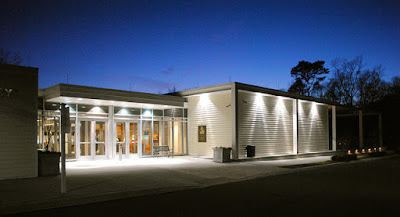Exterior lighting installation for outdoor home - Let's assume you require a brilliant yard light way out in your yard or a remote outlet to control a lake pump or electric instruments. By a long shot the most ideal approach to get electrical power right where you require it is to run underground "line" voltage (120-volt family unit current). All it takes is somewhat electrical moxie and an ability to burrow a shallow trench.
In this article, we demonstrate the most effortless, fastest and least expensive strategy to securely run power outside. Our technique includes specifically covering UF (underground feeder) plastic protected link 12 in. subterranean level. We'll likewise demonstrate to you a no-sweat approach to run the line under a walkway and how to connect the wiring at both finishes.
For this venture, you ought to have the essential wiring abilities it takes to make appropriate associations and the fundamental electrical and carpentry apparatuses. While they're not pivotal, a trench scoop, a mattock and a heavy hammer (Photographs 1 and 2) will make the trench work less demanding and quicker. Permit around a day to finish this venture, accepting you gather every one of the parts ahead of time.
In our venture, we run a line from a current open air outlet on the house to a light and repository at the edge of a garden way. It joins a mix light switch/outlet (Photograph 11). The outlet is constantly hot, and the switch controls just the light. In the event that you don't have an outside box to tap into, consider introducing one on your home.
You can extend the venture to incorporate extra outlets, switches and lights. The methods for running the wire and mounting electrical boxes are the same. Be that as it may, make a point not to over-burden the circuit.
While we encased the electrical boxes inside an empty post, you can essentially mount a weatherproof box in favor of a 4x4, the length of you ensure the link by running it in course from the trench base to the case.
Step 2: Arranging the wire course
Begin by figuring out where you need the electrical post situated and after that discover the closest existing outlet to supply the power. That outlet must be GFCI ensured. We utilized the nearest outlet on the house, however carport outlets are likewise great applicants. By code, those outlets ought to be GFCI ensured. To ensure the "feeder" outlet you pick is secured, search for the trademark GFCI catches, or if it's a standard outlet, check it with a GFCI analyzer. Standard outlets still might be GFCI ensured by being connected to another GFCI outlet somewhere else in the house. In the event that yours isn't ensured, essentially supplant the standard outlet with another GFCI outlet utilizing the procedures we appear as a part of Photograph 13 and Figure A. Another choice is to cut in, mount and wire another outside GFCI outlet, nourishing it from an outlet mounted on an inside divider in the house. Once in a while that is less demanding than burrowing a long trench to a more removed power source.
You likewise need to ensure the new outlet/light won't over-burden the circuit you tie into, and that the container is sufficiently enormous to handle the extra wire. To figure out if the circuit you need to utilize can deal with the extra electrical request, first stop the circuit in the primary board. At that point experience the house turning on lights and other electrical things. Include the wattage of everything that stays off (the things on the circuit). At that point add on the wattage of the post light in addition to the wattage of things persistently fueled by the outlet. We prescribe a greatest associated heap of 1,440 watts for a 15-amp circuit and 1,920 watts for a 20-amp circuit (the amperage is stamped on the breaker or wire). On the off chance that the aggregate wattage surpasses these sums, locate an alternate circuit. In case you're not certain, bring in an authorized circuit repairman to help with this part.
To figure the base box estimate required by the National Electrical Code, include: 1 for each hot and impartial wire entering the case, 1 for all the ground wires joined, 1 for every one of the clips consolidated and 2 for every gadget (switch, repository or blend gadget) introduced in the container. Duplicate this figure by 2 for 14-gage wire and 2.25 for 12-gage wire to get the base box volume in cubic inches. Plastic boxes have the volume stamped inside.
Once you've chosen a power source, pick the most straightforward way for a 12-in. profound trench for the new link. Give trees a generous amount of space to abstain from cleaving through roots. Approach walkways or ways at right plots for simpler burrowing and make a point to arrange a 3-ft. long straight area of trench on one side of the walkway. That is so you'll have space for driving the course underneath it (Photograph 2). Stamp the course with paint and afterward call the service organizations to check any underground lines. (Keep in mind the phone and link organization if those lines are underground.) Last you'll have to get an electrical allow. Your neighborhood building reviews office either concedes those or will guide you to a state office. The auditor will need to see the trench with the link set up before you fill it back in, and after that again for a last examination after the venture is done.







